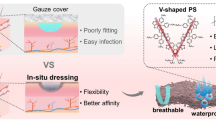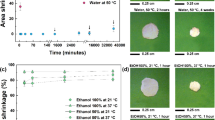Abstract
Irreversible electroporation (IRE) is a kind of promising cancer treatment technology. However, local recurrence still occurs because of incomplete ablation. The aim of this study was to investigate the combined therapy of IRE and a hydroxycamptothecin loaded electrospun membrane (EM/HCPT) to treat rabbit VX2 subcutaneous cancer. HCPT loaded membranes were developed by electrospinning. Mechanical test and in vitro drug release study of EM/HCPT were performed. 24 rabbits with subcutaneous VX2 tumor were randomly divided into four groups: the control group, the EM/HCPT group, the IRE ablation group, and the IRE + EM/HCPT group. The tumor cells were ablated by IRE first, followed by subcutaneous implantation of EM/HCPT to release HCPT constantly in order to damage the residual cancer cells. The tumor inhibition efficacy was assessed by the tumor real-time monitoring, histological and immunofluorescent analyses, and transmission electron microscopy (TEM) examination. Assessment of the release from EM/HCPT showed that HCPT release lasted for about 7 days. The in vivo antitumor efficacy assessment, histological and immunofluorescent analyses, and TEM examination showed that IRE + EM/HCPT had the best tumor inhibition ability. In addition, the biochemical analyses and hematoxylin and eosin (H&E) staining of normal organs indicated that IRE + EM/HCPT treatment was safe. Our study provided a new concept in cancer treatment and might promote the application of IRE.







Similar content being viewed by others
References
U. Aggarwal, A.K. Goyal, G. Rath, Development and characterization of the cisplatin loaded nanofibers for the treatment of cervical cancer. Mater. Sci. Eng. C Mater. Biol. Appl. 75, 125–132 (2017)
R. Cannon, S. Ellis, D. Hayes, G. Narayanan, R.C. Martin 2nd, Safety and early efficacy of irreversible electroporation for hepatic tumors in proximity to vital structures. Eur. J. Surg. Oncol. 107(5), 544–549 (2013)
W. Cui, X. Li, X. Zhu, G. Yu, S. Zhou, J. Weng, Investigation of drug release and matrix degradation of electrospun poly(DL-lactide) fibers with paracetanol inoculation. Biomacromolecules 7(5), 1623–1629 (2006)
M. Figini, X. Wang, T. Lyu, Z. Su, D. Procissi, V. Yaghmai, et al., Preclinical and clinical evaluation of the liver tumor irreversible electroporation by magnetic resonance imaging. Am. J. Transl. Res. 9(2), 580–590 (2017)
Y. Guo, Y. Zhao, T. Wang, R. Li, M. Han, Z. Dong, et al., Hydroxycamptothecin Nanorods Prepared by Fluorescently Labeled Oligoethylene Glycols (OEG) Codendrimer: Antitumor Efficacy in Vitro and in Vivo. Bioconjug. Chem. 28(2), 390–399 (2017)
H. Jiang, Y. Hu, Y. Li, P. Zhao, K. Zhu, W. Chen, A facile technique to prepare biodegradable coaxial electrospun nanofibers for controlled release of bioactive agents. J. Control. Release 108(2–3), 237–243 (2005)
G. Kourounis, P. Paul Tabet, D. Moris, A. Papalambros, E. Felekouras, F. Georgiades, et al., Irreversible electroporation (Nanoknife(R) treatment) in the field of hepatobiliary surgery: Current status and future perspectives. Journal of B.U.ON.: Official Journal of the Balkan Union of Oncology 22(1), 141–149 (2017)
E.W. Lee, C. Chen, V.E. Prieto, S.M. Dry, C.T. Loh, S.T. Kee, Advanced hepatic ablation technique for creating complete cell death: irreversible electroporation. Radiology 255(2), 426–433 (2010)
J. Li, Z. Sun, J. Zhang, H. Shao, M.M. Cona, H. Wang, et al., A dual-targeting anticancer approach: soil and seed principle. Radiology 260(3), 799–807 (2011)
J.N. Li, W.G. Xu, J.J. Chen, D. Li, K. Zhang, T.J. Liu, et al., Highly Bioadhesive Polymer Membrane Continuously Releases Cytostatic and Anti-Inflammatory Drugs for Peritoneal Adhesion Prevention. ACS Biomater Sci. Eng. 4(6), 2026–2036 (2018)
Z. Liu, H. Li, Y. Fan, Y. Liu, S. Man, P. Yu, et al., Combination treatment with Rhizoma Paridis and Rhizoma Curcuma longa extracts and 10-hydroxycamptothecin enhances the antitumor effect in H22 tumor model by increasing the plasma concentration. Biomed. Pharmacother. 83, 627–634 (2016)
R.C. Martin 2nd, D. Kwon, S. Chalikonda, M. Sellers, E. Kotz, C. Scoggins, et al., Treatment of 200 locally advanced (stage III) pancreatic adenocarcinoma patients with irreversible electroporation: safety and efficacy. Ann. Surg. 262(3), 486–494 (2015) discussion 492–4
L. Qinglin, X. Wenxiu, Z. Like, Fangluo, C. Gang, H. Ping, A study on the anti-tumor mechanism of total flavonoids from radix tetrastigmae against additional cell line based on COX-2-mediated Wnt/beta-catenin signaling pathway, Oncotarget (2017).
N. Saderi, M. Rajabi, B. Akbari, M. Firouzi, Z. Hassannejad, Fabrication and characterization of gold nanoparticle-doped electrospun PCL/chitosan nanofibrous scaffolds for nerve tissue engineering. J. Mater. Sci. Mater. Med. 29(9) (2018)
O.F. Sarioglu, A. Ozdemir, K. Karaboduk, T. Tekinay, Comparative serum albumin interactions and antitumor effects of Au(III) and Ga(III) ions. J. Trace Elem. Med. Biol. 29, 111–115 (2015)
S.V. Sudakaran, J.R. Venugopal, G.P. Vijayakumar, S. Abisegapriyan, A.N. Grace, S. Ramakrishna, Sequel of MgO nanoparticles in PLACL nanofibers for anti-cancer therapy in synergy with curcumin/beta-cyclodextrin. Mater. Sci. Eng. C Mater. Biol. Appl. 71, 620–628 (2017)
J.A. Vogel, E. van Veldhuisen, P. Agnass, J. Crezee, F. Dijk, J. Verheij, et al., Time-Dependent Impact of Irreversible Electroporation on Pancreas, Liver, Blood Vessels and Nerves: A Systematic Review of Experimental Studies. PloS one 11(11), e0166987 (2016)
H. Wang, J. Feng, G. Liu, B. Chen, Y. Jiang, Q. Xie, In vitro and in vivo anti-tumor efficacy of 10-hydroxycamptothecin polymorphic nanoparticle dispersions: shape- and polymorph-dependent cytotoxicity and delivery of 10-hydroxycamptothecin to cancer cells. Nanomed.: Nanotechnol., Biol. Med. 12(4), 881–891 (2016)
J.J. Wendler, R. Ganzer, B. Hadaschik, A. Blana, T. Henkel, K.U. Kohrmann, et al., Irreversible electroporation. Current value for focal treatment of prostate cancer. Der Urologe. Ausg. A 54(6), 854–862 (2015)
C. Zhang, D. Pan, K. Luo, W. She, C. Guo, Y. Yang, et al., Peptide dendrimer-Doxorubicin conjugate-based nanoparticles as an enzyme-responsive drug delivery system for cancer therapy. Adv. Healthc. Mater. 3(8), 1299–1308 (2014)
M. Zhu, X.A. Lin, X.M. Zha, W.B. Zhou, T.S. Xia, S. Wang, Evaluation of the therapeutic efficacy of sequential therapy involving percutaneous microwave ablation in combination with 131I-hypericin using the VX2 rabbit breast solid tumor model. PloS one 10(3), e0120303 (2015)
A. Zimmerman, D. Grand, K.P. Charpentier, Irreversible electroporation of hepatocellular carcinoma: patient selection and perspectives. Journal of Hepatocellular Carcinoma 4, 49–58 (2017)
Acknowledgements
We thank Elixigen Corporation (Huntington Beach, California, USA) for helping in proofreading and editing the English of final manuscript.
Author information
Authors and Affiliations
Corresponding authors
Ethics declarations
Conflict of interest
The authors report no declarations of interest.
Rights and permissions
About this article
Cite this article
Wang, L., Chang, J., Qu, Y. et al. Combination therapy comprising irreversible electroporation and hydroxycamptothecin loaded electrospun membranes to treat rabbit VX2 subcutaneous cancer. Biomed Microdevices 20, 88 (2018). https://doi.org/10.1007/s10544-018-0336-y
Published:
DOI: https://doi.org/10.1007/s10544-018-0336-y




